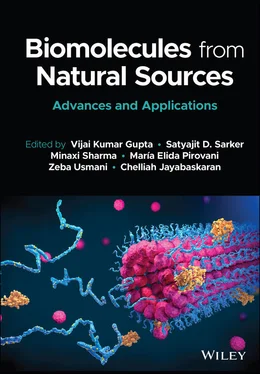Biomolecules from Natural Sources
Здесь есть возможность читать онлайн «Biomolecules from Natural Sources» — ознакомительный отрывок электронной книги совершенно бесплатно, а после прочтения отрывка купить полную версию. В некоторых случаях можно слушать аудио, скачать через торрент в формате fb2 и присутствует краткое содержание. Жанр: unrecognised, на английском языке. Описание произведения, (предисловие) а так же отзывы посетителей доступны на портале библиотеки ЛибКат.
- Название:Biomolecules from Natural Sources
- Автор:
- Жанр:
- Год:неизвестен
- ISBN:нет данных
- Рейтинг книги:5 / 5. Голосов: 1
-
Избранное:Добавить в избранное
- Отзывы:
-
Ваша оценка:
- 100
- 1
- 2
- 3
- 4
- 5
Biomolecules from Natural Sources: краткое содержание, описание и аннотация
Предлагаем к чтению аннотацию, описание, краткое содержание или предисловие (зависит от того, что написал сам автор книги «Biomolecules from Natural Sources»). Если вы не нашли необходимую информацию о книге — напишите в комментариях, мы постараемся отыскать её.
An up-to-date exploration of new and novel biomolecules Biomolecules from Natural Sources: Advances and Applications,
Biomolecules from Natural Sources: Advances and Applications
Natural Sources: Advances and Applications
Biomolecules from Natural Sources — читать онлайн ознакомительный отрывок
Ниже представлен текст книги, разбитый по страницам. Система сохранения места последней прочитанной страницы, позволяет с удобством читать онлайн бесплатно книгу «Biomolecules from Natural Sources», без необходимости каждый раз заново искать на чём Вы остановились. Поставьте закладку, и сможете в любой момент перейти на страницу, на которой закончили чтение.
Интервал:
Закладка:
Surfactant-related parameters are surface tension, maximum surface excess value, minimum surface area occupied by the surfactant molecule at the air–water interface at saturated adsorption, the minimum concentration of the surfactant required to reduce surface tension and the Gibbs free energy of adsorption (Marqués et al. 2009). The interfacial tension, the emulsification index, and the hydrophilic lipophilic balance (HLB) are other important surface active parameters. The interfacial tension is usually measured by tensiometry. The emulsification index is the direct indication of the amount of surfactant. Afterwards the emulsification index can be monitored during the course of fermentation to evaluate the production of trehalose lipids, by mixing an equal volume of cell free broth and liquid paraffin (Cooper and Goldenberg 1987).
Moreover, surface tension has a tendency to decrease with the increase of glycolipid concentration. The structural diversity of glycolipids structures originate different surfactant properties. Generally they are able to reduce the surface tension of water to 43–24.1 mN m -1and present CMC values of 0.7–37 mg L -1(Marqués et al. 2009; Tuleva et al. 2009; Yakimov et al. 1999).
The trehalose lipids are able to reduce the surface tension of the water, for instance from 72 to 34 mN m -1(Janek et al. 2018). This is in agreement with most trehalose lipids produced from Rhodococcus , with strong surface activity by lowering water surface below 30 mN m -1, lowering the interfacial tension against hexadecane up to 1 mN m -1. An example, is a purified trehalose lipid, produced by a novel marine bacterium Rhodococcus sp. PML026 using sunflower oil as a hydrophobic substrate, being able to reduce the surface tension of water to 29 mN m -1with a CMC value of 250 mg L -1(White et al. 2013).
Marqués et al. (2009) analyzed the chemical and physical properties of a glycolipid synthesized by Rhodococcus sp. 51T7. They demonstrated that this biosurfactant was a trehalose tetraester (THL) consisting of six components: one major and five minor. The hydrophobic moieties ranged in size from 9 to 11 carbons. The critical micelle concentration (CMC) was 37 mg L -1and the interfacial tension against hexadecane was 5 mN m -1. At pH 7.4 the trehalose lipid CMC/critical aggregation concentration (CAC) was 50 mg L -1and at pH 4 it was 34 mg L -1(Marqués et al. 2009). A break at around 40 mg L -1was consistent with the CMC/CAC obtained from surface tension measurements. An increase in pH (4–7.4), CAC values increased as the more negatively charged carboxylate group of trehalose lipid tends to complicate aggregation. When NaCl was added at pH 7 trehalose lipid behaved in a non-ionic way and the CAC was unaffected. A phase diagram showed effective emulsification with water and paraffin or isopropyl myristate. A composition of 11.3–7.5–81.8% (isopropyl myristate–trehalose lipid–water) was stable for at least three months. The HLB was 11 and the phase behaviour of the glycolipid revealed the formation of lamellar and hexagonal liquid-crystalline textures (Marqués et al. 2009).
Depending on the Rhodococcus sp . the different trehalose lipids produced changes in interfacial tensions, critical micelle concentrations and emulsifier index and biologic activity.
1.9 Biologic Activity
As mentioned before glycolipids have a wide range of applications. Since trehalose lipids are able to reduce the surface tension of aqueous solutions and the interfacial tension between aqueous and oil phases and have low CMCs, they are especially used as emulsifiers, foaming, wetting (Mujumdar et al. 2019), solubilizers anti-adhesive and antimicrobial agents, among others.
Therefore, trehalose lipids show great potential in different fields (Kuyukina et al. 2001; Mutalik et al. 2008). They are able to act in diverse industries, including (i) the environmental industry with applications such as microbial-enhanced oil recovery, biodegradation of polycyclic aromatic hydrocarbons or oil-spill treatment, (ii) the food industry, where trehalose lipids are especially used as emulsifiers, foaming, wetting, solubilizers anti-adhesive, and anti-microbial agents, (iii) the cosmetics industry and most importantly in (iv) the biomedical field with properties like anti-microbial (Sen et al. 2017), anti-viral (Azuma et al. 1987), anti-tumor activities (Franzetti et al. 2010; Gudiña et al. 2013) (e.g. inhibitory activity on calcium-dependent protein kinase C of human promyelocytic leukemia HL60 cells, inhibitory effects in growth and differentiation-induced against human leukemia cells (Baeva et al. 2014; Kuyukina et al. 2007; Paulino et al. 2016) and immunomodulation activity (Paulino et al. 2016).
Moreover, they can act as therapeutic agents due to their functions in cell membrane interactions. Many studies showed the influence of trehalose lipid interaction with membranes, proteic models, and enzymes, demonstrating the role and hypothetical action site of these biosurfactants (DeBosch et al. 2016).
In the work of Mclaughlin et al. 1980, a tumor regression was seen in guinea pigs bearing transplantable, line-10 hepatocellular carcinoma when synthetic muramyl dipeptides combined with trehalose dimycolate in oil-in-water emulsions were injected directly into the tumors.
In 1996 succinoyl trehalose lipid extracted from n -hexadecane culture of Rhodococcus erythropolis SD-74 remarkably inhibited the growth of a human monocytoid leukemic cell line (Isoda et al. 1997). In a recent study, trehalose lipids proved to be potent in reducing breast cancer cell viability and ineffective on the contractility of rat mesenteric arteries in vitro (Kadinov et al. 2020).
The work of Natsuhara et al. (1990) revealed an anti-tumor effect of trehalose dimycolates (TDM) from Rhodococcus ruber M1 on a subcutaneously implanted sarcoma-180 and allogeneic sarcoma of mice, which was accompanied by significant granuloma formation in lungs, spleen and liver and elevated levels of TNF- a (Natsuhara et al. 1990). The abilities of trehalolipids from Rhodococcus to induce TNF- a determine their antitumor activities (Natsuhara et al. 1990).
The biological activity of several succinoyl trehalose lipids (STL) from Rhodococcus erythropolis SD-74 was investigated by Isoda et al. (1996). They found that STL induced cell differentiation into monocytes instead of cell proliferation in human myeloid (HL60), monocytoid (U937), and erythroid (K562 and KU812) leukemia cell lines. Additionally they found that biological effects of STL were dependent on the structure of hydrophobic moiety (Isoda et al. 1997; Sudo et al. 2000). Pretreatment of U937 cells with STL evolved their phagocytic activity (Isoda et al. 1997), by increasing the presence of cells with Fc receptors for bacterial recognition and, after the phagocytic uptake of PK-2 dye or opsonized yeast particles (Groves et al. 2008; Matsumoto et al. 2016; Ribeiro et al. 2012). Gein et al. (2011) showed that lipids, in the forms mono-acyl trehalose and di-acyl trehalose, produced by Rhodococcus ruber IEGM 23 in a culture medium containing n -dodecane, prevented the adhesion of human monocytes to polystyrene surfaces and inhibited their cytokine production without any cytotoxic effects in vitro. This was assessed measuring the inhibition of proliferative activity of cultured human peripheral blood lymphocytes. Trehalose lipids were also studied in emulsions as immunomodulatory and anti-tumor agents (Matsumoto et al., 2013; Kuyukina et al., 2015). Cytokine stimulating activity and an increased tumor necrosis factor-α (TNF-α), interleukin (IL)-1β, and IL-6 production were observed with trehalose lipids, when applied to the adherent human peripheral blood monocyte culture (Gein et al. 2011).
Читать дальшеИнтервал:
Закладка:
Похожие книги на «Biomolecules from Natural Sources»
Представляем Вашему вниманию похожие книги на «Biomolecules from Natural Sources» списком для выбора. Мы отобрали схожую по названию и смыслу литературу в надежде предоставить читателям больше вариантов отыскать новые, интересные, ещё непрочитанные произведения.
Обсуждение, отзывы о книге «Biomolecules from Natural Sources» и просто собственные мнения читателей. Оставьте ваши комментарии, напишите, что Вы думаете о произведении, его смысле или главных героях. Укажите что конкретно понравилось, а что нет, и почему Вы так считаете.


![Джеймс Купер - Пионеры, или У истоков Саскуиханны [The Pioneers, or The sources of the Susquehannah]](/books/395797/dzhejms-kuper-pionery-ili-u-istokov-saskuihanny-t-thumb.webp)









